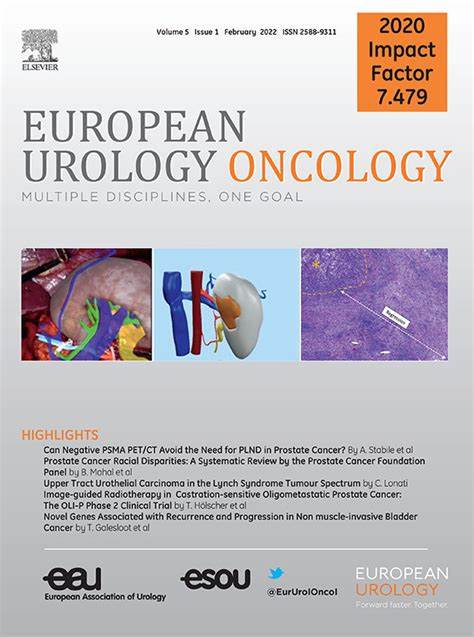Hematuria Cancer Risk Score with Ultrasound Informs Cystoscopy Use in Patients with Hematuria
IF 8.3
1区 医学
Q1 ONCOLOGY
引用次数: 0
Abstract
Background
Hematuria is a cardinal symptom of urinary tract cancer and would require further investigations.
Objective
To determine the ability of renal bladder ultrasound (RBUS) with the Hematuria Cancer Risk Score (HCRS) to inform cystoscopy use in patients with hematuria.
Design, setting, and participants
The development cohort comprised 1984 patients with hematuria from 40 UK hospitals (DETECT 1; ClinicalTrials.gov: NCT02676180) who received RBUS. An independent validation cohort comprised 500 consecutive patients referred to secondary care for a suspicion of bladder cancer.
Outcome measurements and statistical analysis
Sensitivity and true negative of the HCRS and RBUS were assessed.
Results and limitations
A total of 134 (7%) and 36 (8%) patients in the development and validation cohorts, respectively, had a diagnosis of urinary tract cancer. Validation of the HCRS achieves good discrimination with an area under the receiver operating characteristic curve of 0.727 (95% confidence interval 0.648–0.800) in the validation cohort with sensitivity of 95% for the identification of cancer. Utilizing the cutoff of 4.500 derived from the HCRS in combination with RBUS in the development cohort, 680 (34%) patients would have been spared cystoscopy at the cost of missing a G1 Ta bladder cancer and a urinary tract cancer patient, while 117 (25%) patients would have avoided cystoscopy at the cost of missing a single patient of G1 Ta bladder cancer with sensitivity for the identification of cancer of 97% in the validation cohort.
Conclusions
The HCRS with RBUS offers good discriminatory ability in identifying patients who would benefit from cystoscopy, sparing selected patient cohorts from an invasive procedure.
Patient summary
The hematuria cancer risk score with renal bladder ultrasound allows for the triage of patients with hematuria who would benefit from visual examination of the bladder (cystoscopy). This resulted in 25% of patients safely omitting cystoscopy, which is an invasive procedure, and would lead to health care cost savings.
利用超声波进行血尿癌症风险评分,为血尿患者进行膀胱镜检查提供依据。
背景:血尿是尿路癌的主要症状,需要进一步检查:血尿是尿路癌的主要症状,需要进一步检查:目的:确定肾膀胱超声(RBUS)和血尿癌症风险评分(HCRS)为血尿患者进行膀胱镜检查提供依据的能力:开发队列包括来自英国 40 家医院的 1984 名接受 RBUS 检查的血尿患者(DETECT 1;ClinicalTrials.gov:NCT02676180)。一个独立的验证队列包括500名因怀疑患有膀胱癌而转诊至二级医疗机构的连续患者:结果测量和统计分析:评估了 HCRS 和 RBUS 的敏感性和真阴性:在开发队列和验证队列中,分别有 134 名(7%)和 36 名(8%)患者确诊为尿路癌。HCRS 的验证取得了良好的鉴别效果,验证队列的接收器操作特征曲线下面积为 0.727(95% 置信区间为 0.648-0.800),癌症鉴别灵敏度为 95%。如果在开发队列中将 HCRS 与 RBUS 结合使用得出的临界值定为 4.500,则有 680 名(34%)患者可免于膀胱镜检查,但代价是漏诊一名 G1 Ta 膀胱癌和一名尿路癌患者,而有 117 名(25%)患者可免于膀胱镜检查,但代价是漏诊一名 G1 Ta 膀胱癌患者,验证队列中癌症鉴定的灵敏度为 97%:患者总结:血尿癌症风险评分与肾脏膀胱超声相结合,可对血尿患者进行分流,使其受益于膀胱直观检查(膀胱镜检查)。这使得25%的患者安全地省去了膀胱镜检查这一侵入性手术,从而节省了医疗成本。
本文章由计算机程序翻译,如有差异,请以英文原文为准。
求助全文
约1分钟内获得全文
求助全文
来源期刊

European urology oncology
Multiple-
CiteScore
15.50
自引率
2.40%
发文量
128
审稿时长
20 days
期刊介绍:
Journal Name: European Urology Oncology
Affiliation: Official Journal of the European Association of Urology
Focus:
First official publication of the EAU fully devoted to the study of genitourinary malignancies
Aims to deliver high-quality research
Content:
Includes original articles, opinion piece editorials, and invited reviews
Covers clinical, basic, and translational research
Publication Frequency: Six times a year in electronic format
 求助内容:
求助内容: 应助结果提醒方式:
应助结果提醒方式:


